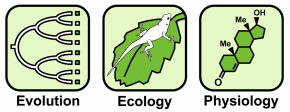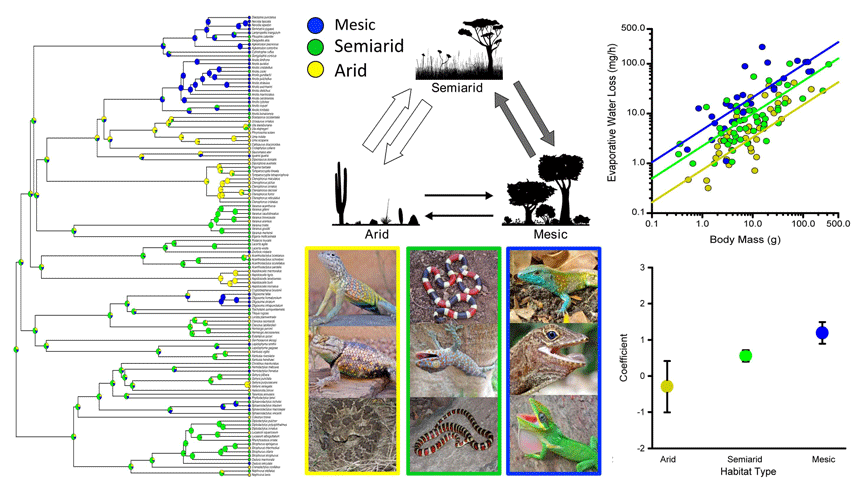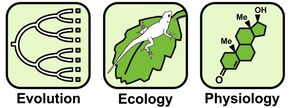Evaporative water loss
All terrestrial organisms must maintain water balance to avoid dessication, but this challenge is particularly acute for organisms in arid environments. While Bob was a postdoc at Ohio State, he worked with Joe Williams' lab group to explore how birds change the lipid composition of their skin to alter the rate of water loss across their skin surface. This work revealed that house sparrows can reduce their whole-animal rates of cutaneous water loss by nearly 45% in as little as a few weeks when exposed to arid conditions, a remarkable degree of phenotypic plasticity!
More recently, we've begun to explore the evolution of evaporative water loss (the overall rate at which an animal loses water through respiration and across the skin) in lizards and snakes inhabiting arid, semiarid, and mesic environments. The figure above summarizes results from Cox & Cox (in press), in which we found that evolutionary shifts toward more arid habitats are consistently associated with reductions in whole-animal rates of evaporative water loss.
Relevant publications
Cox, C.L., and R.M. Cox. 2015. Evolutionary shifts in habitat aridity predict evaporative water loss across squamate reptiles. Evolution 69: 2507-2516.
Cox, R.M., A. Muñoz-Garcia, M.S. Jurkowitz, and J.B. Williams. 2008. β-Glucocerebrosidase activity in stratum corneum of house sparrows following acclimation to high and low humidity. Physiological and Biochemical Zoology 81:97-105
Muñoz-Garcia, A., R.M. Cox, and J.B. Williams. 2008. Changes in cutaneous water loss and skin lipids of house sparrows (Passer domesticus) following acclimation to high or low humidity. Physiological and Biochemical Zoology 81: 87-96.
Cox, C.L., and R.M. Cox. 2015. Evolutionary shifts in habitat aridity predict evaporative water loss across squamate reptiles. Evolution 69: 2507-2516.
Cox, R.M., A. Muñoz-Garcia, M.S. Jurkowitz, and J.B. Williams. 2008. β-Glucocerebrosidase activity in stratum corneum of house sparrows following acclimation to high and low humidity. Physiological and Biochemical Zoology 81:97-105
Muñoz-Garcia, A., R.M. Cox, and J.B. Williams. 2008. Changes in cutaneous water loss and skin lipids of house sparrows (Passer domesticus) following acclimation to high or low humidity. Physiological and Biochemical Zoology 81: 87-96.


